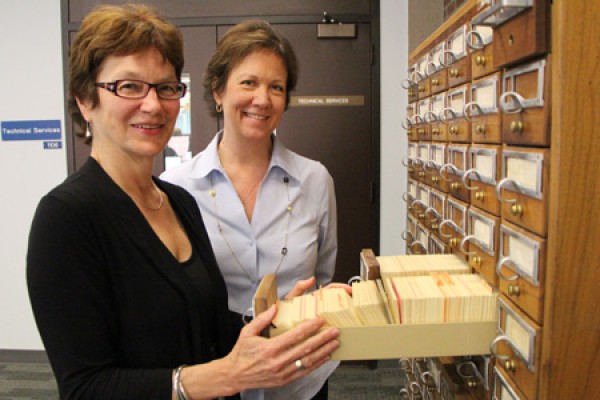 Gwendolyn Ebbett, left and Joan Dalton stand beside one of the last remaining, and now obsolete, card catalogues in the Leddy Library.
Gwendolyn Ebbett, left and Joan Dalton stand beside one of the last remaining, and now obsolete, card catalogues in the Leddy Library.
The Leddy Library has seen numerous alterations over the last 50 years, but none compare to the way the introduction of information technology changed the way it does business.
“We used to have these huge, wooden cabinets of card catalogues, and that was how the students accessed all of our information,” said Gwendolyn Ebbett, dean of the library. “Much of the first floor was cabinets.”
These days, students access the library’s massive collection of books, journals and periodicals through personal devices or the more than 270 public computers that have replaced those wooden cabinets since the late 1980s when the transition to digital access began.
Before that transition, library patrons required an exact title match, author or subject to search the card catalogue, before trudging off to various sections of the building to locate the material they needed. Today, they can simply type something resembling the source into the online catalogue’s search interface, and the system will populate a list of matches and tell them if the material is available. There’s no need to go to the shelves to check, and they may even have the option of downloading one of the library’s one million e-books.
Ebbett, who began working in academic libraries as a cataloguer in 1974, has been a close and passionate observer of the extraordinary changes the library world has experienced since she started.
“It’s just amazing, the changes that we’ve gone through,” she said. “I think being a librarian is one of the most exciting ways of engaging with new technology.”
Ebbett and Joan Dalton, one of the library’s two associate deans, recall that in earlier days a small army of librarians had to hand-write all the cards stored in the library’s catalogues. Eventually they moved to using an analog 35 mm camera mounted on a frame to take pictures of the publication information in the book, which was stored with the card.
While the change to digital access has dramatically improved the library’s service, both librarians recall a time when the suggestion to make that switch was less than warmly embraced.
“Our faculty was reluctant about going digital at first,” notes Dalton. “There was a lot of skepticism, which is natural.”
Ebbett said some called the change “crazy and irresponsible.”
“There was this notion that paper was more permanent and there was a suspicion that somehow all this data would be lost,” she said.
Ensuring all that data wouldn’t be lost has always been one of the library’s top priorities, Ebbett said. The Leddy is a member of the Ontario Council of University Libraries, which recently had trusted digital repository status conferred upon its Scholars Portal database by the U.S.-based Centre for Research Libraries. It took five years of work to meet the rigorous criteria and data storage technical standards to earn that status.
“We’re the only ones in Canada who have that designation and Windsor was actively involved as a member of OCUL,” Ebbett said.
In many regards, Ebbett added, the Leddy – named in 1977 in honour of former UWindsor president John Francis Leddy – has led Canadian universities in the way it has embraced new technology.
“We were an early adopter of open access technology,” said Dalton. “That’s helped expose a lot more content and create an open access culture here. We’re using technology in a much more sophisticated way.”

